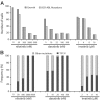Comparison of imatinib mesylate, dasatinib (BMS-354825), and nilotinib (AMN107) in an N-ethyl-N-nitrosourea (ENU)-based mutagenesis screen: high efficacy of drug combinations
- PMID: 16772610
- PMCID: PMC1895563
- DOI: 10.1182/blood-2006-02-004580
Comparison of imatinib mesylate, dasatinib (BMS-354825), and nilotinib (AMN107) in an N-ethyl-N-nitrosourea (ENU)-based mutagenesis screen: high efficacy of drug combinations
Abstract
BMS-354825 (dasatinib) and AMN107 (nilotinib) are potent alternate Abl inhibitors with activity against many imatinib mesylate-resistant BCR-ABL kinase domain (KD) mutants, except T315I. We used N-ethyl-N-nitrosourea (ENU)-exposed Ba/F3-p210(BCR-ABL) cells to compare incidence and types of KD mutants emerging in the presence of imatinib mesylate, dasatinib, and nilotinib, alone and in dual combinations. Although ENU is expected to induce mutations in multiple proteins, resistant clones were almost exclusively BCR-ABL KD mutant at relevant concentrations of nilotinib and dasatinib, consistent with a central role of KD mutations for resistance to these drugs. Twenty different mutations were identified with imatinib mesylate, 10 with nilotinib (including only 1 novel mutation, E292V) and 9 with dasatinib. At intermediate drug levels the spectrum narrowed to F317V and T315I for dasatinib and Y253H, E255V, and T315I for nilotinib. Thus, cross-resistance is limited to T315I, which is also the only mutant isolated at drug concentrations equivalent to maximal achievable plasma trough levels. With drug combinations maximal suppression of resistant clone outgrowth was achieved at lower concentrations compared with single agents, suggesting that such combinations may be equipotent to higher-dose single agents. However, sequencing uniformly revealed T315I, consistent with the need for a T315I inhibitor, to completely block resistance.
Figures



References
-
- O'Brien SG, Guilhot F, Larson RA, et al. Imatinib compared with interferon and low-dose cytarabine for newly diagnosed chronic-phase chronic myeloid leukemia. N Engl J Med. 2003;348: 994-1004. - PubMed
-
- Deininger M, Buchdunger E, Druker BJ. The development of imatinib as a therapeutic agent for chronic myeloid leukemia. Blood. 2005;105: 2640-2653. - PubMed
-
- Talpaz M, Silver RT, Druker BJ, et al. Imatinib induces durable hematologic and cytogenetic responses in patients with accelerated phase chronic myeloid leukemia: results of a phase 2 study. Blood. 2002;99: 1928-1937. - PubMed
-
- Sawyers CL, Hochhaus A, Feldman E, et al. Imatinib induces hematologic and cytogenetic responses in patients with chronic myelogenous leukemia in myeloid blast crisis: results of a phase II study. Blood. 2002;99: 3530-3539. - PubMed
-
- Gorre ME, Mohammed M, Ellwood K, et al. Clinical resistance to STI-571 cancer therapy caused by BCR-ABL gene mutation or amplification. Science. 2001;293: 876-880. - PubMed
Publication types
MeSH terms
Substances
Grants and funding
LinkOut - more resources
Full Text Sources
Other Literature Sources
Miscellaneous

